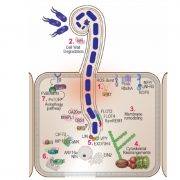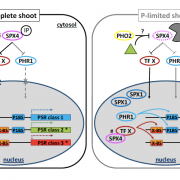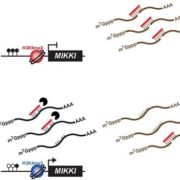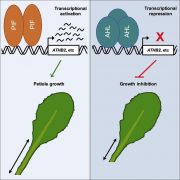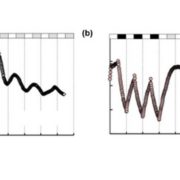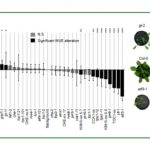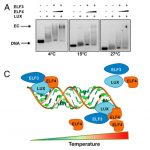GIGANTEA shapes the photoperiodic rhythms of termomorphogenic growth in Arabidopsis (Mol. Plant)
 Plants evolved molecular mechanisms to integrate seasonal changes with developmental programs. For example, warmer temperatures and increasing day-length mark the transition from winter to spring, and trigger flowering. Now, the synchronisation of ambient temperature and photoperiod is perturbed by global warming, which causes growth alteration in different plant species. Nevertheless, plants are able to modify their architecture to dissipate heat through a process called thermomorphogenesis. One of these responses relies on hypocotyl elongation, and is mediated by the thermo-sensory function of phytochromes. The activation of PHYTOCHROME INTERACTING FACTOR 4 (PIF4) at warm temperatures promotes the accumulation of auxin, causing hypocotyl overgrowth. This thermo-induced response is also coordinated by day-length through regulatory mechanisms still unresolved. In this paper, Park et al. provide a link between photoperiod sensing and thermomorphogenesis. They investigated thermo-induced responses in Arabidopsis using loss of function mutations in GIGANTEA (GI), a clock component previously involved in photoperiodic flowering and chaperone activity. Further protein-protein interaction studies indicated that GI accumulation at warm temperatures under Long Days causes the stabilisation of PIF4 suppressors DELLA. By contrast, reduced GI protein levels and increased degradation of DELLAs under Short Days associate with the release of PIF4, which triggers hypocotyl elongation mediated by increased auxin biosynthesis. (Summary by Michela Osnato) Mol. Plant 10.1016/j.molp.2020.01.003
Plants evolved molecular mechanisms to integrate seasonal changes with developmental programs. For example, warmer temperatures and increasing day-length mark the transition from winter to spring, and trigger flowering. Now, the synchronisation of ambient temperature and photoperiod is perturbed by global warming, which causes growth alteration in different plant species. Nevertheless, plants are able to modify their architecture to dissipate heat through a process called thermomorphogenesis. One of these responses relies on hypocotyl elongation, and is mediated by the thermo-sensory function of phytochromes. The activation of PHYTOCHROME INTERACTING FACTOR 4 (PIF4) at warm temperatures promotes the accumulation of auxin, causing hypocotyl overgrowth. This thermo-induced response is also coordinated by day-length through regulatory mechanisms still unresolved. In this paper, Park et al. provide a link between photoperiod sensing and thermomorphogenesis. They investigated thermo-induced responses in Arabidopsis using loss of function mutations in GIGANTEA (GI), a clock component previously involved in photoperiodic flowering and chaperone activity. Further protein-protein interaction studies indicated that GI accumulation at warm temperatures under Long Days causes the stabilisation of PIF4 suppressors DELLA. By contrast, reduced GI protein levels and increased degradation of DELLAs under Short Days associate with the release of PIF4, which triggers hypocotyl elongation mediated by increased auxin biosynthesis. (Summary by Michela Osnato) Mol. Plant 10.1016/j.molp.2020.01.003
[altmetric doi=”10.1016/j.molp.2020.01.003″ details=”right” float=”right”]


